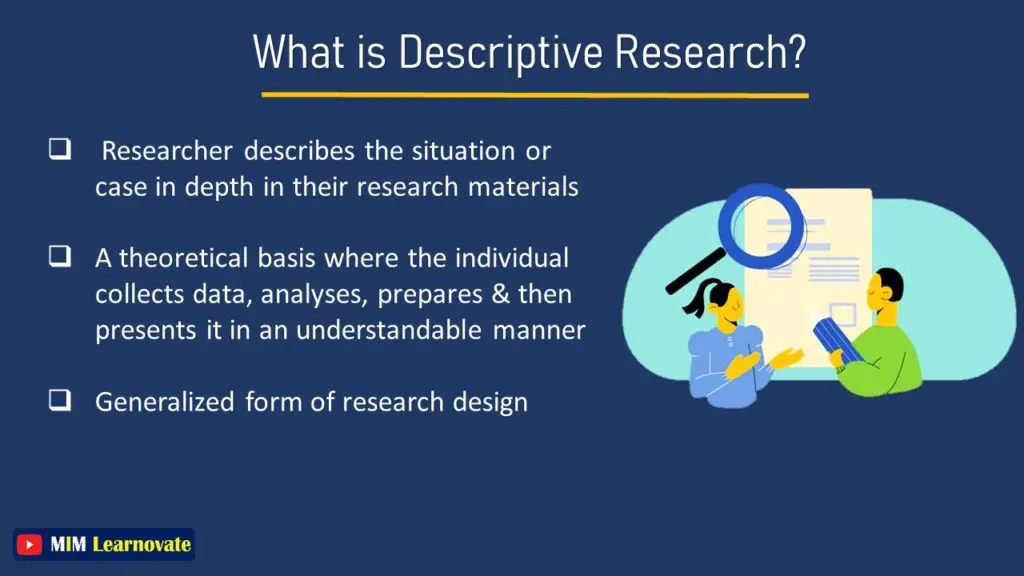Table Of Content

For the most part AD is a condition that affects older people and experiences of participants caring for older people will ultimately dominate the sample. However, AD also affects younger people and how this will impact on sampling needs to be considered before recruitment as both groups will have very different experiences, although there will be overlap. Teddlie and Fu (2007) suggest that although some purposive sampling techniques generate representative cases, most result in describing contrasting cases, which they argue are at the heart of qualitative analysis. To achieve this, Sandelowski (2010) suggests that maximum variation sampling is particularly useful in qualitative descriptive research, which may acknowledge the range of experiences that exist especially in healthcare research.
Performance appraisal: Definition, benefits, steps and methods
There are different examples of descriptive research, that may be highlighted from its types, uses, and applications. A survey will be carried out to gather enough data about the income of the employees, then their performance will be evaluated and compared to their income. This will help determine whether a higher income means better performance and low income means lower performance or vice versa. For example, an investor considering an investment in the ever-changing Amsterdam housing market needs to understand what the current state of the market is, how it changes (increasing or decreasing), and when it changes (time of the year) before asking for the why.
Why Use Voxco for Descriptive Research Design?
The information gathered from investigating a case study may be generalized to serve the larger group. Consider the case of individuals who want to invest in stock markets, so they evaluate the changes in prices of the available stocks to make a decision investment decision. Descriptive research uses a quantitative research method by collecting quantifiable information to be used for statistical analysis of the population sample. When studying human behaviour based on a factor or event, the researcher observes the characteristics, behaviour, and reaction, then use it to conclude. A company willing to sell to its target market needs to first study the behaviour of the market.

Theme 3: pride in reconnecting with and contributing to society
Simultaneously, the WHO [1] reported a deficit of 5.9 million nurses in 2018, with the shortfall in the number of nurses expected to reach 10.6 million by 2030 [2]. This trend is primarily driven by the mounting demand for nursing services stemming from population aging dynamics. Moreover, the aging composition of the nursing workforce exacerbates the existing shortage of nurses. Currently, 17% of the global nursing population is aged 55 years or over [2], and projections indicate that within the upcoming decade, approximately 4.7 million nurses are expected to retire [3]. This means that an estimated annual influx of 47,000 new nurses is required just to sustain the current nursing workforce. Failure to meet this demand will probably intensify the nursing shortage at an accelerating pace.
“Relying on Voxco as our survey software provider has proved to be an excellent choice for our business.”
Surveys should involve a mix of closed-ended and open-ended questions, as both have their own advantages. The findings of descriptive research can help inform decision-making, policy development, and program planning. One of the most prominent characteristics of descriptive research is that, unlike in experimental research, the variables are not controlled or manipulated. A good example of this would be an anthropologist who wanted to study a tribe without affecting their normal behavior in any way. True experiments, whilst giving analyzable data, often adversely influence the normal behavior of the subject. Many scientific disciplines, especially social science and psychology, use this method to obtain a general overview of the subject.
This aligns with previous studies emphasizing their high levels of clinical and leadership skills [20, 28] and the enthusiasm exhibited by returners [30]. While initially struggling to adjust, their experience enables them to quickly adapt [33]. Once they regain competence, they contribute to healthcare and society by providing competent nursing care, educating colleagues, and serving as successful examples for potential returners. These experiences may instill a career calling characterized by self-actualization, personal fulfillment, and passion for their work [49], which promote job satisfaction [50] and engagement [51]. Returning to work also allows them to establish their societal position and expand their network, which is limited when solely fulfilling household responsibilities.
Survey Research
Cartographer: job description - Careers advice - TARGETjobs
Cartographer: job description - Careers advice.
Posted: Wed, 19 Jul 2023 07:00:00 GMT [source]
Additionally, managers need to assist returners in regaining their confidence and should support their progress toward achieving personal goals. Encouraging self-reflection on their clinical experiences can serve as a powerful means to help them realize the extent of their growth and subsequently enhance their confidence [31]. Assisting them in setting future professional goals represents another important strategy. Finally, managers should help returners recognize the positive changes that have occurred in their family dynamics as a result of their return to work.
Key points for policy, practice and/or research
These included providing educational resources, having a person-centred care delivery model when responding to sexual expression and providing guidance when working with families. Findings from this qualitative descriptive study provide recommendations that can then feed in to a broader policy on sexual expression in long-term care settings. Content and thematic analyses are the most commonly used data analysis techniques in qualitative descriptive research. Vaismoradi et al. (2013) argue that content and thematic analysis, although poorly understood and unevenly applied, offer legitimate ways of a lower level of interpretation that is often required in qualitative descriptive research.
Financial support and sponsorship
Inconsistency in decision making within the research process coupled with a lack of transparency has created issues of credibility for this type of approach. It can be difficult to clearly differentiate what constitutes a descriptive research design from the range of other methodologies at the disposal of qualitative researchers. Available statistics show that there is an estimated population of approximately 700,000–860,000 inactive nurses in Japan [17], the United States [18] and Germany [19]. Several studies have demonstrated that a significant proportion of surveyed inactive nurses, ranging from 43 to 85%, expressed a desire to return to nursing practice [20, 21]. Similarly, a more recent study conducted in Taiwan reported that incentives for returning to practice included the improvement of the nurse staffing level, and the provision of a safer working environment and re-entry preparation programs [20].
As the descriptive research design often employs the use of surveys, data can be collected from a very large sample size quickly and cost-effectively. It can either quantify the distribution of certain variables (quantitative descriptive research) or simply report the qualities of these variables without quantifying them (qualitative descriptive research). Most qualitative research aligns itself with non-probability sampling and descriptive research is no different. Descriptive research generally uses purposive sampling and a range of purposive sampling techniques have been described (Palinkas et al., 2015). Many researchers use a combination of approaches such as convenience, opportunistic or snowball sampling as part of the sampling framework, which is determined by the desired sample and the phenomena being studied.
The higher the number of times it is conducted, the more authentic the conclusion will be. For example, a survey evaluating the number of hours millennials in a community spends on the internet weekly, will help a service provider make informed business decisions regarding the market potential of the community. This is because it provides basic information about the research problem, which may give birth to other questions like why a particular thing is the way it is. It can also be carried out using the qualitative research method, to properly describe the research problem.
“Although it was only 3 years, I did have a work gap, so I was thinking that my skills and knowledge might be obsolete and that I might have forgotten some things, but this hospital has a very detailed manual.” (ID 06). “From the day after I started working, I had my own room, and on that day, someone from the day shift always made it a point to talk to me and support me, and it felt like fate. I thought if I were being supported this much, I should do the same, and well, everyone in the ward helped me understand the patients within the week, so much that I thought I already remember them. But I’ve been working alongside him, and he’s been supporting me a lot, such as by taking the kids to school and picking them up after, things like that.” (ID 13). Designers, like painters and sculptors, can use colors, shapes, and other items as a basis for their work. Using creative adjectives when describing a design can create a more dynamic and engaging experience for your reader.
It does not involve manipulating variables or establishing cause-and-effect relationships. Descriptive research is a research method that focuses on providing a detailed and accurate account of a specific situation, group, or phenomenon. This type of research describes the characteristics, behaviors, or relationships within the given context without looking for an underlying cause. Causal research, on the other hand, seeks to determine cause-and-effect relationships between variables.

No comments:
Post a Comment